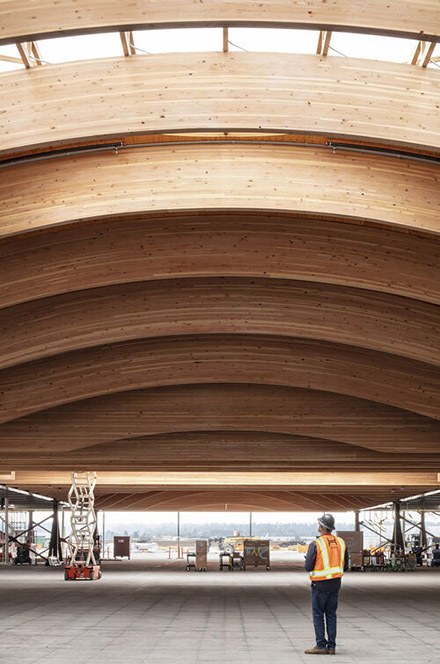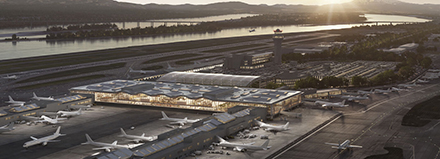When Carpenters Local 1503 member William Smith got a chance to work reconstructing the Portland International Airport’s main terminal in Oregon USA, he left another job to take it. That’s because of the project’s centre piece: A mass timber roof made from Oregon-sourced wood. Sources: North West Labor Press, Timberbiz, photo zgf Architects
Smith was lured to the airport project by its unique features, like working with 80-foot “glulams”— glue-laminated beams, some of which are nine feet wide. The roof also uses MPP (mass plywood panel), a large-format plywood.
Beyond the technical novelties, Smith liked the longevity of the finished product.
“This is a project that’s going to be here for a lifetime,” said Smith, who works for the construction contractor Swinerton. “You know, our kids’ kids’ kids may be walking through here.”
Other union workers on the job feel the same.
“I came out here because it’s a legacy project. Everyone we know is going to see it,” said Michael Peck, another Swinerton employee and member of Carpenters Local 1503. It’s different from most of his jobs, where the woodwork gets mostly covered by structural concrete.
“You get to see your progress when you travel,” said Shikara White, a second-term apprentice with IBEW Local 48 who works for OEG. “It’s one of the few jobs that you can walk through and be like, ‘Oh, I did all the lights here. I worked on those escalators.’”
The terminal roof is part of a five-year $2 billion upgrade that started in 2021. Building and installing the roof is a year-long phase of the terminal work, finishing late this year. Work will then pivot to the terminal’s interior.
The airport upgrade also included a new Concourse B, which opened last year, and a reworked ground transportation hub. The roof is actually being built in 18 sections on the airfield. Workers poured a 10-inch-thick concrete slab and constructed double-girder support towers that hold the roof 13 feet off the ground. Building and installing separately allows workers to do the bulk of construction at 13 feet rather than its installed elevation of about 74 feet.
“That makes it safer; it makes it a lot easier,” said Kama Simonds, spokesperson for the Port of Portland, which operates the airport.
After construction of the roof sections is complete, an engineering firm will transport them across runways to the terminal (another massive undertaking).
Carpenters receive prefabricated wood components that they assemble and move into place, another feature of mass-timber construction. Swinerton worker Nick Phelan, a Carpenters Local 1503 member, says it’s like assembling a giant piece of IKEA furniture. It requires some tweaking to make everything fit properly, but the materials are straightforward to work with. Phelan says it’s easier to work with than concrete, with fewer on-the-job injuries.
“We just get to have fun all day, not get hurt, and the product looks pretty good at the end of the day,” Phelan said.
Carpenters are finishing the lattice on the roof’s underside and installing parapet caps, some of the last touches before the install.
Tucked above the woodwork are insulation panels that will reduce the sound, not only from planes taking off, but from the ambient noise of conversations inside the airport.
J.C. Shepperd, an exterior/interior specialist with Carpenters Local 146, said workers are putting in 11,100 custom-made panels coated with a sound absorbing spray. That gives them different properties from a material like drywall, which sound waves reverberate off of.
“These panels actually absorb 70% of the sound waves in the air,” said Shepperd, who works for construction contractor IES. He’s heard the results firsthand: After workers installed panels in large swaths of the roof, Shepperd’s crew started holding their morning huddle in one of those areas. The sound absorption was “like night and day,” he said.
IBEW Local 48 members are installing electrical conduit to bring power to the roof and for the lighting and fire alarm systems. The conduit runs along the roof’s contours, and rather than hand-bending the conduit like workers anticipated, the project requires custom bending to the shape of the roof.
“We’re installing it by hand, pushing it up, strapping it on, and then it just really curves well with the roof,” White explained. IBEW members are also installing wire for lights that will hang from the latticework.
White started on the project last September when she was a first-term apprentice. She recalls more experienced IBEW members emphasizing how much she would learn by sticking with the project all the way through. She kept that in mind, particularly when it snowed last winter, and outdoor work continued in the cold.
“I’ll freeze for winter, it’s fine,” White laughed, saying the experience gained was worth it.








